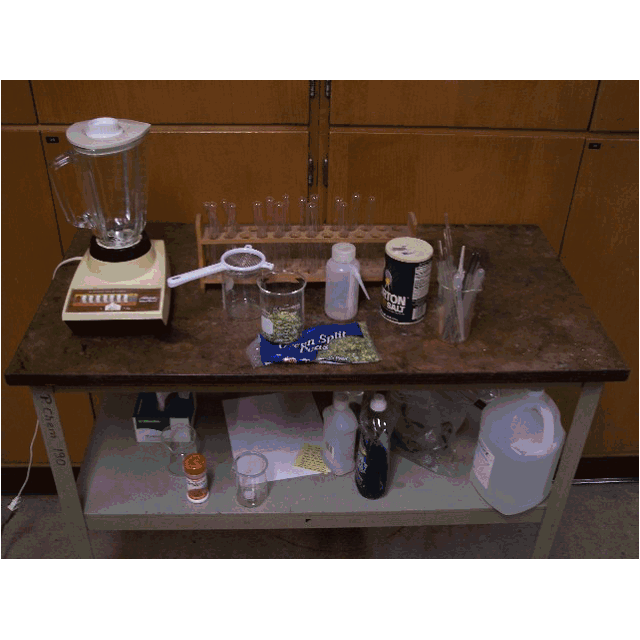Extraction of DNA
- Equipment
Blender, beaker (100 mL), strainer, test tubes (up to10 large tubes and
stoppers if tubes are to be passed around class), stir sticks and test tube
rack
- Reagents
DNA source (split peas work best), salt, water, liquid detergent, meat
tenderizer, alcohol (70% isopropyl alcohol or 95% ethyl alcohol work well)
- Presentation
1. Measure ~100 mL (1/2 cup) DNA source (split peas), pinch of salt (~1
mL or 1/8 tsp), and ~200 mL of water (double the amount of the DNA source)
into blender. Blend on high for 15-20 sec.
2. Pour the "pea soup" through a strainer into a beaker. How
much "soup" do you have? Add a volume of detergent equal to 1/6
of the "pea soup" volume. Mix slightly and let sit for 5-10 minutes.
(This is very important - do not move on to Step 3 without waiting.)
3. Pour soapy "pea soup" in to test tubes; fill each ~1/3 full.
Add a pinch of meat tenderizer to each test tube. Mix VERY gently (or you
will break up the DNA).
4. Tilt the test tube at an angle of ~45°. Pour the alcohol gently
down the side of each test tube until tube are about 2/3 full.
Two layers should form. The DNA will rise into the top layer (alcohol layer).
The DNA can be removed with a stir stick (sometimes).
- Discussion
To extract DNA, you must remove it from the cells of the DNA source such
as the split peas. Blending the peas with some salt and water breaks the
cells apart. However, the DNA is still safely contained in the cell because
of the cell and nuclear membranes. These cell membranes are made up of lipids
(like grease) which have a polar head and a non-polar tail. The detergent
also consists of polar heads and non-polar tails. The molecules in detergent
are able to pull apart the cell and nuclear membranes which leave the DNA
in the "pea soup".
The DNA in the "pea soup" is still covered and protected by the
proteins from the cell. The meat tenderizer (or pineapple juice or contact
lens solution) contain enzymes which are able to cut apart these proteins
to leave the DNA alone. Alcohol is less dense than water and therefore floats
above the "pea soup". The proteins, lipids, and DNA all need to
decide which solution they prefer. The proteins and lipids prefer the water
and the DNA prefers the alcohol. The DNA therefore moves into the alcohol
layer. The DNA formed tends to be stringy and clumped together. You can
try to remove it from the test tubes with a stir stick but it is often difficult
to do so.
Some interesting DNA facts: Each cell of your body contains
six feet of DNA! Our bodies contain about 100 trillion cells - that means
we have more than a billion miles of DNA within our bodies! To fit this
into your cells, the DNA is packed efficiently by twisting tightly and clumping
together.
Some demo tips: This demonstration works for a variety of
DNA sources, detergents, and tenderizers. If you do not see DNA forming, it
may be due to the type of DNA source (see discussion below) or the timing
in the procedure. It is very important to wait the 5-10 minutes in Step 2
or the cell and nuclear membranes will remain intact, not allowing the DNA
to be extracted. If you do not see any DNA immediately, wait 30-60 minutes...
the DNA will usually extract into the alcohol layer with time. Different DNA
sources will yield DNA at different rates. Frozen peas do not make a good
subsititute for split peas due to the large amount of water contained in the
peas. Extracting DNA from onions works well, but the color of the solution
is not as nice. Red cabbage is not a good DNA source as the solution is too
dark and the DNA is extracted rather slowly. Try to experiment with other
sources of DNA!

